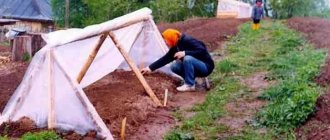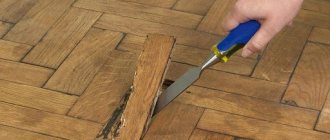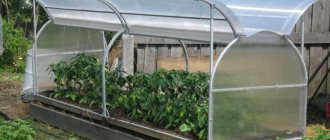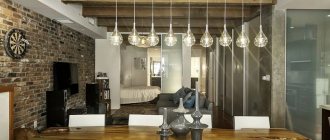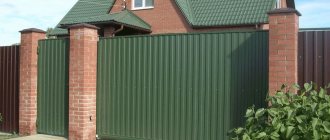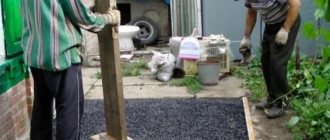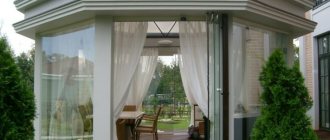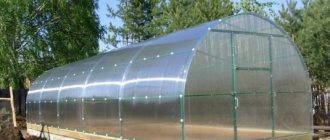If you have a desire to get a good greenhouse, you will first need to decide on its size, as well as understand what type of structure will be most suitable for you.
The choice of material is of considerable importance. The financial costs of installation will directly depend on this.
Since many summer residents do not mind saving money, they must choose inexpensive, but high-quality materials so that the structure does not fall apart a few days after installation.
In this article we will tell you how to make a greenhouse from plastic pipes. Why this particular material? In fact, everything is clear here.
Because this is the easiest to manufacture and, importantly, the most economical option for a greenhouse. Even those who have no experience in this matter can build such a structure.
We will take a step-by-step look at the main stages of greenhouse construction and tell you about all the important nuances. This information will, first of all, be useful to those who have no idea what to do or where to start.
Why is polyvinyl chloride the best material for a greenhouse?
Construction experts recommend using PVC pipes for the following reasons:
- Strength. Such pipes will not break under enormous weight. Studies have shown that one PVC element of an average size can withstand a weight of up to 500 kilograms;
- Elasticity. As you know, to build a greenhouse you need to create arches from pipes. It is quite difficult to do this from metal and wooden materials, while PVC pipes can be easily bent into the desired shape. You can easily make arcs for a greenhouse yourself only if you use PVC as the starting material;
PVC pipes are easy to bend
- Durability. All products made from polyvinyl chloride do not break for decades. Therefore, the greenhouse will be a reliable shelter for your plants for many years.
Interesting options for greenhouses made of PVC pipes
If you decide to make a greenhouse from plastic pipes with your own hands, then polyvinyl chloride is the best material available today.
Characteristics and Features
Since the frame of this type of greenhouse is based on plastic pipes, the properties of the entire structure will largely depend on the characteristics of these pipes. The positive aspects include the following:
- the costs of setting up a greenhouse are minimal , because the cheapest pipes are suitable for these purposes;
- simplicity of design and low weight allows you to quickly and effortlessly install the greenhouse and disassemble it for storage;
- controlling the microclimate in a homemade greenhouse is as easy as in the factory version;
- it is possible to create greenhouses of any size and optimal configuration;
- The service life of such structures is very long, since the plastic does not corrode, rot, or be destroyed by insects.
At the same time, the light weight of the structure creates some difficulties during operation:
- there is a risk of destruction by wind;
- You cannot use ordinary glass.
ATTENTION! Therefore, even at the design stage, you should choose the most wind-protected locations and abandon heavy covering mats.
rials
What do you need to build a greenhouse yourself?
Construction of a greenhouse is quite a fascinating and not complicated process, the main stages of which are presented in the photo below.
The fastest PVC greenhouse
A greenhouse consists of three main elements: foundation, frame, covering. These elements are made from the following materials:
- PVC pipes. It is desirable that their cross-section is 13 mm, since this size is most optimal for creating a greenhouse;
PVC pipes
- Boards. Give preference to treated, durable wood, the thickness of which varies from 20 to 40 millimeters. It is advisable to cover them with transparent varnish before laying - this maneuver will add strength to the structure;
Foundation boards
- Steel wire. Necessary for connecting pipes to each other. Prepare sections from 80 cm to 1 meter. Their number should be twice as large as pipes;
- Coating. For this purpose, you can use a special greenhouse film or polycarbonate sheets. They are strong enough to protect plants from negative environmental factors. In addition, they allow air to pass through, so the crops will not wither;
- You will also need a hammer, pliers, screws, nails and other small items.
Steel bars of various thicknesses
To make greenhouses with your own hands from PVC pipes, stock up on all the above materials in the required quantity. The larger the planned size of the greenhouse, the more materials will be needed.
Related article:
Do-it-yourself greenhouse made from a profile pipe. A separate review provides detailed instructions for the design and construction of a structure from a profile pipe with photo examples.
Selection of materials
The quality of the product also depends on the material used:
- When choosing pipes made of polyvinyl chloride, you need to pay attention to the manufacturer’s certificates. Currently, Czech and Turkish companies produce high-quality products.
PVC pipes are flexible - In order for the greenhouse structure to be strong and reliable, it is necessary to purchase pipes with a wall thickness of at least 4.2 mm with an internal and external diameter of 16.6 and 25 mm, respectively.
- The wall thickness of the connecting fasteners made of thermoset plastic is 3 mm.
- The reinforcing bars must match the diameter of the pipes so that they can fully ensure the rigidity of the greenhouse structure.
Step-by-step instructions for constructing a greenhouse
Creating a greenhouse consists of 4 stages:
- Construction of a timber foundation;
- Installation of fasteners for PVC pipes;
- Installation of arches;
- Covering the greenhouse.
Let's look at each process in more detail.
Construction of a timber foundation
To begin with, it is worth leveling the area that is allocated for the greenhouse. Use a tape measure and steel rods to mark the corners of the greenhouse. Using a level, you can check how level the ground is.
Marking for the greenhouse foundation
Next, dig trenches in the corners of the greenhouse (there should be 4 of them) with a depth of at least 10-15 centimeters. 4 boards are installed there, which serve as the foundation for the greenhouse. These boards should be reinforced with nails and screws. This way it will be possible to achieve better fixation and durability of the greenhouse.
Wood foundation for a greenhouse
Installation of fasteners for PVC pipes
Next, we drive the steel rods into the ground. They need to be installed evenly. To ensure that the length between the rods is the same, count their number, divide by two (one batch for each side) and measure the length of each side with a tape measure. Then calculate the optimal distance between the rods. It is important that they are located opposite each other and that the distance between them is the same. Steel rods are driven into the ground with a hammer. They must stand close to the foundation, that is, to the boards that were previously installed.
The distances between the rods should be the same
Also, to fix the arches, you can use special glasses that are attached directly to the wooden base.
Fastening arches using special PVC glasses
Installation of arches
In order to create arches from plastic pipes, you will need a pipe bender or a hair dryer to heat the pipe and give it the shape of an arc. After the arch is ready, it is put on a steel rod on both sides and secured to the base with a clamp.
Fastening the base of the arch with a clamp to the foundation
After installing all the arches at the top point, a pipe is attached with a wire along the entire length of the greenhouse. This additional stiffening rib will give the structure strength and stability.
Installation of stiffeners to arches
The PVC industry offers a large selection of shaped parts for pipes, so there are special crosses to give the structure a presentable appearance and ease of installation.
A variety of shaped parts can greatly simplify the process of assembling a greenhouse
Thus, in the end you should have a frame with a foundation that you just need to cover with film.
Covering the greenhouse
To stretch the greenhouse film onto the surface of the frame, you will need the help of several people to hold the ends of the sheet. The film is attached with nails to the wooden base. You also need to cut out a separate piece of film that will go under the door. It must be attached to the top side of the entrance to the greenhouse.
Helpful advice! To attach the film to the frame, use pieces of flexible hose cut lengthwise.
A simple way to attach film to a pipe frame
So you can make a greenhouse from PVC plastic pipes with your own hands.
What materials and tools are needed
To make a standard greenhouse, you need to prepare the following materials:
- five-meter boards with a section of 2x6 cm - 4 pieces;
- boards with a section of 2x6 cm, length 3.7 m - 2 pieces;
- PVC pipes 6 m long—19 pieces;
- fittings 3 meters long (Ø10 mm) – 9 pieces;
- PVC film (thickness 6 mm) – 6x15.24 meters;
- wooden slats (length 1.22 m) - 50 pieces;
- nails or screws;
- metal fastenings;
- door hinges - 4 pieces;
- door handles - 2 pieces.
Materials for the ends of the greenhouse:
- timber 2x4 cm 3.7 m long for the frame;
- 11'8 3/4” - 2 beams 3.6 m long;
- 1'6” - 4 bars of 0.45 m each;
- 4'7” - 4 bars of 1.4 m each;
- 5'7” - 4 bars of 1.7 m each;
- 1'11 1/4” - 8 bars of 0.6 m each;
- 4'1/4” - 2 bars of 1.23 m each;
- 4 bars 1.5 m long;
- 4 bars 1.2 m long.
Required tools:
- hammer;
- Bulgarian;
- electric screwdriver;
- hacksaw for metal;
- electric saw;
- building level;
- roulette.
Do-it-yourself arches from scrap materials
However, arches or arcs for a greenhouse are made not only from metal or plastic. There are other materials and methods that may be suitable in your case.
Table. What can greenhouse arcs be made from?
Polycarbonate greenhouse
The frame serves as a kind of skeleton on which the entire greenhouse structure rests. Therefore, it is necessary to approach the choice of material here with special care. The most inexpensive and common option is a wooden frame. More details in this article.
Preparing the base
A greenhouse made from PVC pipes is lightweight, so it does not need . At the same time, the presence of a frame will give strength to the frame and maintain its shape during operation. Let's consider options for preparing the base for various types of structures:
- Wooden frame. It is most appropriate to use it for an arched greenhouse, but it is also suitable for building in the form of a house. To make the frame, you need to prepare the following materials: boards 1.5-3 mm thick or bars 6X12 , 8X12 . A rectangular frame is knocked down or twisted using self-tapping screws from the prepared material. Using a tape measure, check the diagonal of the frame to avoid misalignment of the sides. Fix the manufactured frame with pieces of reinforcement on the soil so that it does not move around the site. The pins are driven into the corners inside the frame.
- Metal pins. You can attach the pipes to pieces of metal reinforcement driven directly into the soil. This design will be lighter compared to a greenhouse on a wooden base. For such a foundation, metal rods 70-80 cm long are driven along the length of the future structure on both sides. The pins are driven into the ground half the length at a distance of 50 cm from each other.
- A metal frame made of pipes with pins welded to them or a base assembled from the same PVC pipes . Such a base can only be made using a welding machine. Its advantage is maximum mobility of the structure. The frame together with the frame can be easily moved to any place on the site. Alternatively, instead of a frame, you can make two pipes equal to the length of the greenhouse tunnel and weld pins to them. Such pipes are laid on the ground and fixed with metal slingshots. In this case, at your discretion, you can change the width of the greenhouse depending on the installed pipes.
IMPORTANT! The wooden frame must be treated with an antiseptic so that fungus does not develop on it. If this is not done, the frame will last one year and will be unusable by the next season.
Greenhouse diagram - polyvinyl chloride frame:
Durable metal arcs for greenhouses
The most durable for large greenhouse sizes are metal arcs, however, to assemble the entire structure, you need welding equipment, or drilling holes for a bolted connection. For the frame of the greenhouse, you can use galvanized profile pipes, which can last up to 20 years.
Nuances:
- A grinder is used to trim the metal profile.
- After drilling holes for fastening, trimming damages the galvanized layer of the profile.
- The drilled areas must be treated with cold zinc.
- Cold zinc will protect metal profiles from corrosion, which will increase service life.
Galvanized profiles can be joined by welding. This is the most rational way to combine all the elements of a greenhouse.
Welding is better than using a large number of bolts, rivets, and self-tapping screws.
Welding damages the galvanized coating, and the joints must be treated with a wire brush and cold zinc applied.
What should the arcs for a greenhouse be like?
Before we find out what material is ideal for making arcs for a greenhouse, let's talk about what an arched greenhouse is. This is a kind of tunnel, which is made from several arcs in a row stuck into the ground and covered with film or agrofibre. This structure is installed over a bed, which is usually heated not only by the sun, but also by the process of natural processing of biofuel placed under the ground. As a rule, this is a fairly lightweight structure and, if necessary, it can be moved to another, ordinary bed without any additional heating.
The function of a greenhouse is simple and understandable even to a novice gardener - this design allows you to retain heat around the plants and protect them during frosts. Also, a greenhouse is an excellent structure for hardening off seedlings in the spring, when it is already warm outside during the day, but at night it is cool for young plants.
A greenhouse can be installed on a foundation, but this is rarely done. In particular, it doesn’t even make sense to place an arched greenhouse on a foundation, since in this case it can’t be moved to another place so easily.
Now it’s time to talk about the arcs - arranged in one row, they will play the role of a greenhouse frame. It is with the help of arcs that the covering material will be held over the bed. We can say this is the main part of any greenhouse. Therefore, it is so important to be careful and careful when choosing arcs. Depending on the material from which they are made, these frame parts can have different quality. However, which of them is better is an open question, since often disadvantages in certain situations become advantages. So what should the arcs for a greenhouse be like? They must have the full properties described in the table below.
Table. Basic properties of arcs for a greenhouse.
| Property | Characteristic |
| Strength | This is one of the main characteristics. The arches should, at a minimum, not break from simple touches, and even more so not crack and fall apart during rain or snow. Also, if you plan to periodically drag the greenhouse from place to place, the arcs should not crack at the ends. Unfortunately, this is often the case with industrial models, which sometimes cost a lot of money. Also, the arcs should easily withstand even wet covering material. |
| Ease of use | The arches should require as little attention and care as possible from the gardener, so as not to distract him from working in his garden. They must also be light enough so that even a person who does not have great physical strength can move them to another place and transport them, if necessary. |
| Good flexibility | Also quite an important factor for arcs. They should bend well, but at the same time keep their shape. |
| Ease | No one is safe from the fall of a greenhouse, and it may happen that the arcs collapse due to the wind, even if they are sufficiently well secured. If they are made of heavy material, when they fall they will damage all the plantings inside the greenhouse. A light one will break off at most a few leaves of plants. |
| Durability | It makes no sense to make more and more new greenhouses every year; it is much more convenient to use the same one for several years. Therefore, the material for the arcs must be strong and durable enough so as not to collapse in just a season or two of use. |
It is worth noting that, based on all of the above, those arcs that combine all these properties as much as possible can be called high-quality. At the same time, convenient should be convenient, inexpensive and durable. If you decide to make greenhouse arcs yourself, then it is important to choose a material that will be fairly easy to process. Otherwise, you will spend too much time and effort to make even the simplest greenhouse. Let's take a closer look at the two main materials from which greenhouse arcs are made.
Prices for arcs for a greenhouse
Arcs for greenhouse
An arched greenhouse is an indispensable assistant for any gardener, both experienced and beginner. It is this design that can be assembled quite quickly if you need to cover the garden bed during frosts. And it’s easy and simple to disassemble if necessary - you don’t have to make any special efforts. An arched structure (both factory-made and home-made) is assembled from arc-shaped elements, which you can make yourself if you wish. What types of greenhouse arcs are there, and what can you make them from with your own hands?
